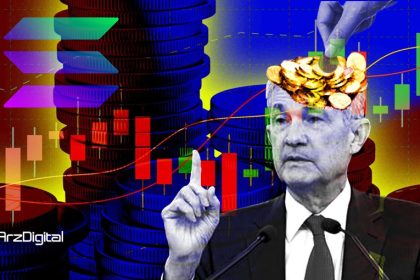Digital currency is a type of virtual money that has revolutionized financial transactions using blockchain technology and cryptography. With the growth of blockchain technology and its impressive capabilities, various types of digital currency have emerged in this market to use this technology to meet the needs of traders and investors from different aspects.
Getting to know the types of digital currency and introducing some popular and popular currencies are among the topics that we will review in the rest of the article.
What are the types of digital currency?
Today, more than a decade has passed since the birth of digital currencies, these currencies are no longer limited to Bitcoin and there are different types of them in the market. The most important Types of digital currency They are:
- token (non-homosexual, sovereign, securities, rapid, fandom)
- Queen (stablecoin, memecoin)
Digital currency is a new form of digital assets with more than ten years history that has found its place among other financial markets. Satoshi Nakamoto introduced the first digital currency to the world in 2009 by launching Bitcoin. After the growth of Bitcoin, other digital currencies started their activities one after another.
Today, digital currencies have various uses. They can be a means of exchanging money. Also, many companies and businesses see digital currencies as a way to receive and pay fees and rewards to their customers. In addition, many investors and traders believe that digital currencies create value, which can be investigated in its place.
Using digital currencies has many advantages. Transferring money with digital currencies is faster and cheaper than traditional methods. The second issue is that digital currencies are not subject to inflation. Also, financial transactions with digital currencies are more transparent and traceable. In general, the mission of digital currencies is to change the international financial system towards greater transparency and efficiency.
In the first part of this section, we had a look at the types of digital currency. In the following sections, we will examine each of these types more carefully.
token
Types of digital currency can be divided into two main categories: tokens and coins. Tokens include NFTs (Non-Featured Tokens), Sovereign Tokens, Securities Tokens and others. Coins also include stablecoin and memecoin. In the following, we will get to know the most important types of these digital currencies.
Tokens are generally non-minable digital units that are created on the blockchain platform. Tokens have different forms; They can be used as currency for specific ecosystems or encode unique data.
In addition, some tokens may be redeemable for off-chain assets (such as gold, property and stocks).
Tokens are generally created by entities or companies that use existing valid blockchains such as Ethereum.
Based on the different features and uses of each token, there are various categories for them. In the rest of the article, we will examine the nature of tokens together.
Non-currency Token (NFT)
Non-Fungible Token or NFT (Non-Fungible Token) is a type of digital asset or a unique data unit that is registered in a digital distributed ledger called Blockchain. Each NFT has its own characteristics and information that distinguish it from other tokens. In this regard, it is not possible to directly trade or exchange these tokens, unlike ordinary digital currencies.
Combining blockchain cryptographic technology with the unique features of NFTs helps verify and prove the key features of any tokenized asset. Often bought and sold through cryptocurrency exchanges, these tokens have a value that depends on market pricing and their owners.
The main use of these tokens is in areas where uniqueness and originality are important. For example, in the field of art, artists are able to convert their works to NFT and benefit from the possibility of preventing fraud and copying.
Overall, non-fungible tokens allow artists and creators to monetize their creativity in a new way; Something that was not possible in the past. These tokens guarantee authenticity, authenticity, value, credibility, integrity, rarity and ownership of assets. Also, various fields such as art, real estate, and real estate have become interested in the capabilities of non-traditional tokens.
Governance token
One of the goals of creating and introducing Bitcoin as the first digital currency was to increase people’s control over assets and decentralize financial activities; A goal that today is considered as the main pillar of digital currencies and blockchain technology.
After the release of Bitcoin and the expansion of the use of blockchain technology, blockchain organizations were also looking for ways to conduct community-oriented activities so that the power is not in the hands of a single person or small group. Currently, this goal can be achieved with the help of governance tokens.
Many traditional centralized companies are run by one person or a board of directors. These small management groups have a lot of power and can determine how to manage the budget and the overall strategy of the project.
This management group is not required to seek the opinion or approval of the project community and customers for their decisions; For this reason, most of the time, the company works in line with the interests of these management people.
To solve this problem, the use of governance tokens has become popular in decentralized blockchain organizations and companies to provide a more fair, decentralized and transparent governance and management method.
These organizations are called Decentralized Autonomous Organization or DAO (DAO), which can operate completely independently without central management. The sovereign token has provided this opportunity for the mentioned institutions to develop fairly and healthy.
Security Token
Securities token is another type of digital currency and a special type of token in the world of digital currencies and blockchain technology, which has its own unique features. This token is recognized as a symbol of ownership of assets and property outside the domain of centralized networks.
Securities tokens are mainly created for the purpose of representing ownership of company shares, real estate, real estate, and other valuable assets. The value of these tokens is directly derived from the value of their underlying asset. This means that the value of the security token is directly related to the value of its underlying asset.
Securities tokens are usually under the supervision of legislative bodies and are required to comply with the laws and regulations related to securities. This token will be distributed through a process called “Securities Token Initial Offering” (STO).
In this process, a certain number of tokens are produced and marketed based on the value of the underlying asset. Investors can then obtain these tokens and buy and sell them on reputable exchanges and platforms.
The main difference between the securities token and other tokens is that this token has a backing asset; In other words, its value is tied to the value of the property related to it. Conversely, other tokens are mostly generated and used without specific backing.
Also, the securities token is obliged to comply with the rules and regulations of the securities industry; While other tokens usually operate in a decentralized manner without central supervision.
Wrapped Token
Rapid Token represents the connection between the digital world and physical assets. These tokens derive their value from digital currency or physical assets such as gold, stocks, and real estate. Also, due to this connection and using smart contracts in the blockchain, and especially in DeFi platforms, Rapid Tokens are used.
Rapid is a complex word in digital language and represents the token’s relationship with the underlying asset. These tokens can act as representatives in blockchains and provide the possibility of exchange and interaction in the space of digital currencies. They represent every possible type of asset, including artwork, commodities, digital assets, stocks, bonds, fiat currencies, and even real estate.
Through this connection with non-native assets, Rapid Tokens create a bridge between networks and offer the possibility of diverse exchanges. Due to the fact that Rapid Tokens are connected to other assets, custodial institutions play an important role in managing this connection. These entities are responsible for linking tokens with assets and canceling or establishing this link.
Rapid Bitcoin (wBTC) was implemented as the first rapid token using smart contracts on the Ethereum blockchain. Currently, there are other rapid tokens that mostly use ERC-20 Ethereum and BEP-20 standards of Binance Smart China.
Fan Token
Fan Tokens or Fan Tokens are cryptographic digital assets that provide the opportunity to monetize the connection between fans and sports teams. These tokens can be bought and sold like other types of digital currency and at the same time act as a currency for buying goods, collections and even participating in special sports events.
Fan Tokens are made based on blockchain technology. However, users don’t need to get involved with the intricate details of blockchain. They view tokens like numbers or points in their mobile apps, which makes the platform easier for regular users to use.
Queen

Coin, or digital currency, is a type of virtual currency that uses blockchain technology and cryptography to create and transfer it. Coins operate independently of central banks. Decentralized networks regulate and control them.
There are different types of coins such as Bitcoin, Ethereum, Litecoin and many other currencies that have different uses and features; But they all work based on blockchain technology.
Stablecoin
Stablecoins are digital currencies that use different methods to maintain their price and value stability. The main purpose of these currencies is to create price stability similar to strong fiat currencies for digital currencies. This has gradually turned these currencies into a bridge for financial and investment institutions.
Initially, stablecoins were designed to reduce the price fluctuations of digital currencies and functioned as a means of transferring value in financial transactions. Over time, these currencies have gained a wider role.
Currently, trying to enter the decentralized financial world (DeFi) and the field of ordinary banking, reducing transaction costs and reducing financial pressures have been proposed as important goals of these stable coins.
The use of stable coins in these areas shows the ability of these currencies to improve their efficiency and practicality in digital asset communities.
meme coin
Memecoins are a group of digital currencies inspired by internet memes and jokes.
Dogcoin was the first coin meme that was created in 2013, inspired by the image of a Japanese dog named Shiba Inu. After the success of Dogecoin, other memecoins such as Shiba Ino and Akita Ino emerged. These meme coins usually have no practical use and are designed for fun and prank purposes only.
The main advantage of meme coins is their low price and their availability to the general public; But since they don’t have a value base, they are very volatile and have a lot of risk for investors.
Also, due to the high supply, it is inflationary and the possibility of stable price growth in them is low; Therefore, one should carefully decide on investing in them.
The most popular types of digital currencies
Some of the most popular and popular types of digital currency in the market are Bitcoin, Ethereum, Binance Coin, Dogecoin, Shiba Inu, Cardano, Solana, Polkadata and Ripple. These currencies have gained a lot of popularity among digital currency investors and traders due to various reasons, including strong supporting technology, active user community, diverse applications, and of course high price growth.
Bitcoin
Bitcoin is the first digital currency based on blockchain and the king of digital currencies. This currency was introduced to the digital currency market in 2009 by an unknown person or group with the pseudonym Satoshi Nakamoto.
Bitcoin revolutionized the financial world by providing a decentralized payment system that operates without intermediaries. Today, Bitcoin is still the largest and most popular digital currency in the world with more than 60% market share.
Ethereum
Ethereum is the second largest digital currency after Bitcoin, which Vitalik Buterin introduced to the world of digital currencies in 2015. Unlike Bitcoin, Ethereum is a platform for creating smart contracts that enable the implementation of blockchain-based applications. Ethereum has been able to attract many fans by providing the infrastructure to create exchanges, games and such activities.
Binance Coin
Binance Coin is the popular digital currency of the Binance exchange, which was launched in 2017. This digital currency allows users to buy and sell digital currency on the Binance exchange by paying a lower fee.
Also, Binance Coin has shown that it can be considered as a long-term investment currency. With the development of Binance exchange activities, it is expected that the value and popularity of Binance Coin will also increase.
Doge coin
Dogecoin is a digital currency that started as a joke and is now among the top 10 currencies in the digital currency market with a value of several tens of billions of dollars, and even famous personalities like Elon Musk support it.
Dogecoin is a meme coin that uses blockchain technology. Like Bitcoin and other digital currencies, money transfer in this network is done in a decentralized manner. However, it has many differences with Bitcoin and other digital currencies, and among the most important of them is its primary purpose; Dogecoin was originally created as a joke.
The word “Doge” and the image of a Shiba dog were known as a meme (internet humor) that people used to write their own funny texts. Therefore, unlike other digital currencies, Dodge was not created for a specific purpose from the beginning and is now known as a “memecoin”.
Shiba Ino
Shiba Inu is without a doubt one of the controversial, news-making and high-profile digital currencies of recent years. The Shiba Inu is an ERC-20 token based on the Ethereum blockchain, inspired by a Japanese dog breed of the same name. This token is implemented on the Ethereum blockchain and, unlike some currencies, does not have its own blockchain.
The Shiba Inu has also gained popularity outside of the digital currency sphere and has become an internet meme for expressing emotions in the face of strange and funny events. This use of the name and image of the Shiba Inu dog has turned it into a “Meme Coin”.
Investment in various digital currencies

In the last decade, investing in digital currencies has become popular. Currencies such as Bitcoin and Ethereum have a dynamic and volatile market and their prices may fluctuate quickly. This dynamic makes investing in these markets very risky.
However, the long-term profitability of investing in digital currencies has attracted some users and investors and has brought significant profits to them.
There are also different ways to invest in digital currencies. One of these methods is to buy and hold or keep long-term digital currencies such as Bitcoin or Ethereum and store them in a personal digital wallet.
Another method is to invest in digital currency mutual funds, which allow investors to invest in this market without the need for high technical knowledge. In addition, the use of derivative instruments such as futures contracts and digital currency options are also other options for earning profit.
Investing in digital currencies comes with advantages and disadvantages. Its advantages include high yield potential, easy and quick access, independence and deflation.
On the other hand, extreme fluctuations in currency prices, guaranteeing low returns, the risk of hacking or theft of assets, and the risk of losing capital due to forgetting the password are the disadvantages of this type of investment. Therefore, investors should manage these challenges and opportunities carefully and with sufficient knowledge.
RCO NEWS

















